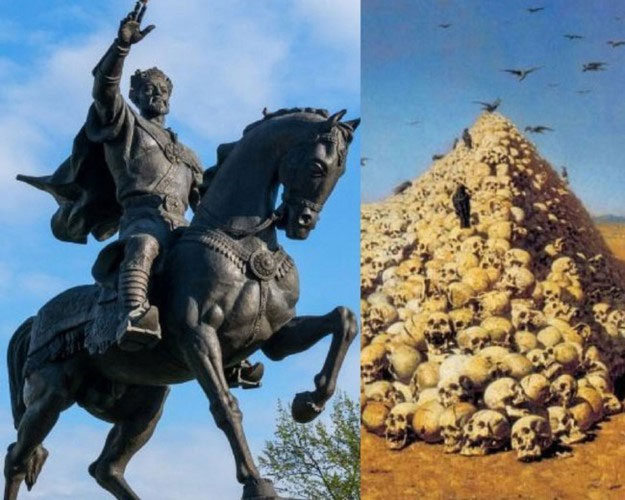There are still many ancient sites around the world filled with unsolved mysteries. These places are often steeped in legends about mysterious powers, causing many to hesitate to approach them.
In Central Asia, there lies the tomb of one of the most infamous tyrants in history, believed to harbor a terrifying curse. What is the truth behind it?
The Tyrant Who Loved Art
In the 14th century, the Turco-Mongol conqueror Timur, also known as Tamerlane, became notorious as one of the most brutal and bloodthirsty invaders in Central Asia. During his fierce campaigns, it is estimated that his army claimed the lives of around 17 million people—an astonishing number given the world population at the time.
Timur established the vast Timurid Empire, which stretched from southern Turkey, Syria, Iraq, Kuwait, and modern-day Iran, through Central Asia, including parts of Kazakhstan, Afghanistan, Azerbaijan, Georgia, Turkmenistan, Uzbekistan, Kyrgyzstan, Pakistan, India, and even reaching Kashgar in China.
Claiming to be a descendant of Genghis Khan, despite having no familial ties to the great khan, Timur is regarded as one of the most brilliant military leaders in history, a master strategist unmatched by many.
As a figure who instilled fear across Asia at that time, stories of Timur’s conquests and death have become legendary. The most famous of these is the pyramid he constructed in India, made from the skulls of 70,000 victims he had massacred.
This stands in stark contrast to his reputation as a patron of architecture and the arts. These works can be seen in his intricately built mausoleum, which not only leaves a lasting impression of architecture but is also believed to harbor a dreadful curse.
A Curse Fulfilled?

Timur – the ruthless conqueror.
Gur-e Amir, which means “Tomb of the King” in Persian, located in present-day Samarkand, Uzbekistan, was considered an architectural wonder of its time. The mausoleum is the final resting place of Timur, who died of illness while attempting to conquer China in 1405 at the age of 68, along with his descendants.
This complex features a bright dome, elaborately decorated with intricately carved tiles and various mosaics, known as a model for later Mughal emperors’ tombs and other mausoleums, even influencing the design of the Taj Mahal in India.
The tomb lay undisturbed for centuries until it was violated. Those who dared to enter discovered a chilling curse associated with the tyrant. The first recorded mention of the curse is believed to have emerged in 1740 when Nader Shah of the Afsharid Empire attempted to steal Timur’s coffin.
It is said that during the excavation, the tombstone unexpectedly split in two. This was immediately seen as a very bad omen. Shah was advised to return the remains. He complied, but it was too late; the Afsharid Empire collapsed shortly after this incident. Since then, it has been rumored that anyone who disturbs Timur’s tomb will face catastrophic consequences.
Before the Nazis invaded the Soviet Union on June 19, 1941, Joseph Stalin dispatched an archaeological team to break into the tomb and excavate Timur’s remains for study. Soviet scientist and anthropologist Mikhail Mikhaylovich Gerasimov was tasked with leading this endeavor.
Upon entering the tomb and opening the coffin, they discovered ominous warnings inscribed on a stone slab, ominously stating: “We are all mortals. The time will come, and we will depart. Anyone who disturbs the ashes of our ancestors will face punishment”; “When I rise from the dead, the whole world will tremble”; and “Anyone who disturbs my tomb will unleash a conqueror more terrible than I.”
These should have been understood as a dire warning to cease their work, but the excavation team ignored the pleas of spiritual sages, even dismissing the complaints of laborers who reported mysterious symptoms of illness.
Ultimately, they managed to bring Timur’s remains back to Moscow for study. Just a few days later, on June 22, 1941, Adolf Hitler’s army unexpectedly attacked Russia in a war that was not declared, resulting in the deaths of approximately 26 million people.
As the enemy invasion intensified, Gerasimov is said to have been haunted by Timur’s curse and sought to send a message to Stalin. In the winter of 1942, he convinced Stalin, who arranged for a special plane to return Timur’s body to the mausoleum, where it was reburied with full honors.
Subsequently, the German army faced successive defeats, and the Soviet Union triumphed in this great patriotic war. Could this be mere coincidence?
It is difficult to ascertain how much of the curse is true and how much is pure legend. Were these merely threats from the conqueror to frighten enemies away from his grave? This site remains open to visitors today, but people are warned not to touch the ancient relics.


















































